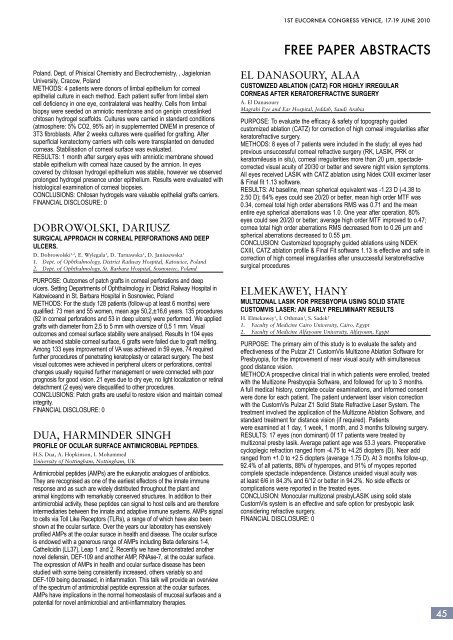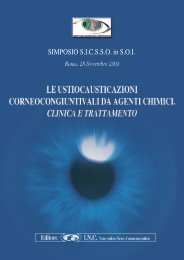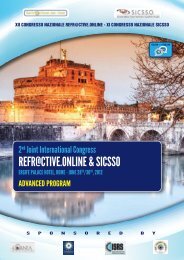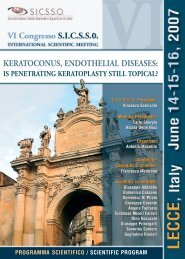1st EuCornea Congress
1st EuCornea Congress
1st EuCornea Congress
You also want an ePaper? Increase the reach of your titles
YUMPU automatically turns print PDFs into web optimized ePapers that Google loves.
<strong>1st</strong> <strong>EuCornea</strong> <strong>Congress</strong> venice, 17-19 june 2010<br />
FREE PAPER Abstracts<br />
Poland. Dept. of Phisical Chemistry and Electrochemistry, , Jagielonian<br />
University, Cracow, Poland<br />
Methods: 4 patients were donors of limbal epithelium for corneal<br />
epithelial culture in each method. Each patient suffer from limbal stem<br />
cell deficiency in one eye, contralateral was healthy. Cells from limbal<br />
biopsy were seeded on amniotic membrane and on genipin crosslinked<br />
chitosan hydrogel scaffolds. Cultures were carried in standard conditions<br />
(atmosphere: 5% CO2, 95% air) in supplememted DMEM in presence of<br />
3T3 fibroblasts. After 2 weeks cultures were qualified for grafting. After<br />
superficial keratectomy carriers with cells were transplanted on denuded<br />
corneas. Stabilisation of corneal surface was evaluated.<br />
Results: 1 month after surgery eyes with amniotic membrane showed<br />
stabile epithelium with corneal haze caused by the amnion. In eyes<br />
covered by chitosan hydrogel epithelium was stabile, however we observed<br />
prolonged hydrogel presence under epithelium. Results were evaluated with<br />
histological examination of corneal biopsies.<br />
Conclusions: Chitosan hydrogels ware valuable epithelial grafts carriers.<br />
Financial disclosure: 0<br />
Dobrowolski, Dariusz<br />
Surgical approach in corneal perforations and deep<br />
ulcers.<br />
D. Dobrowolski 1,2 , E. Wylegala 1 , D. Tarnawska 1 , D. Janiszewska 1<br />
1. Dept. of Ophthalmology, District Railway Hospital, Katowice, Poland<br />
2. Dept. of Ophthalmology, St. Barbara Hospital, Sosnowiec, Poland<br />
Purpose: Outcomes of patch grafts in corneal perforations and deep<br />
ulcers. Setting Departments of Ophthalmology in: District Railway Hospital in<br />
Katowiceand in St. Barbara Hospital in Sosnowiec, Poland<br />
Methods: For the study 128 patients (follow-up at least 6 months) were<br />
qualified: 73 men and 55 women, mean age 50,2,±16,6 years. 135 procedures<br />
(82 in corneal perforations and 53 in deep ulcers) were performed. We applied<br />
grafts with diameter from 2,5 to 5 mm with oversize of 0,5 1 mm. Visual<br />
outcomes and corneal surface stability were analysed. Results In 104 eyes<br />
we achieved stabile corneal surface, 6 grafts were failed due to graft melting.<br />
Among 133 eyes improvement of VA was achieved in 59 eyes, 74 required<br />
further procedures of penetrating keratoplasty or cataract surgery. The best<br />
visual outcomes were achieved in peripheral ulcers or perforations, central<br />
changes usually required further management or were connected with poor<br />
prognosis for good vision. 21 eyes due to dry eye, no light localization or retinal<br />
detachment (2 eyes) were disqualified to other procedures.<br />
Conclusions: Patch grafts are useful to restore vision and maintain corneal<br />
integrity.<br />
FINANCIAL DISCLOSURE: 0<br />
Dua, Harminder Singh<br />
Profile of Ocular surface antimicrobial peptides.<br />
H.S. Dua, A. Hopkinson, I. Mohammed<br />
University of Nottingham, Nottingham, UK<br />
Antimicrobial peptides (AMPs) are the eukaryotic analogues of antibiotics.<br />
They are recognised as one of the earliest effectors of the innate immune<br />
response and as such are widely distributed throughout the plant and<br />
animal kingdoms with remarkably conserved structures. In addition to their<br />
antimicrobial activity, these peptides can signal to host cells and are therefore<br />
intermediaries between the innate and adaptive immune systems. AMPs signal<br />
to cells via Toll Like Receptors (TLRs), a range of of which have also been<br />
shown at the ocular surface. Over the years our laboratory has exensively<br />
profiled AMPs at the ocular surace in health and disease. The ocular surface<br />
is endowed with a generous range of AMPs including Beta defensins 1-4,<br />
Cathelicidin (LL37), Leap 1 and 2. Recently we have demonstrated another<br />
novel defensin, DEF-109 and another AMP, RNAse-7, at the ocular surface.<br />
The expression of AMPs in health and ocular surface disease has been<br />
studied with some being consistently increased, others variably so and<br />
DEF-109 being decreased, in inflammation. This talk will provide an overview<br />
of the spectrum of antimicrobial peptide expression at the ocular surfaces.<br />
AMPs have implications in the normal homeostasis of mucosal surfaces and a<br />
potential for novel antimicrobial and anti-inflammatory therapies.<br />
El Danasoury, Alaa<br />
Customized Ablation (CATZ) for highly irregular<br />
corneas after keratorefractive surgery<br />
A. El Danasoury<br />
Magrabi Eye and Ear Hospital, Jeddah, Saudi Arabia<br />
Purpose: To evaluate the efficacy & safety of topography guided<br />
customized ablation (CATZ) for correction of high corneal irregularities after<br />
keratorefractive surgery.<br />
Methods: 8 eyes of 7 patients were included in the study; all eyes had<br />
previous unsuccessful corneal refractive surgery (RK, LASIK, PRK or<br />
keratomileusis in situ), corneal irregularities more than 20 µm, spectaclecorrected<br />
visual acuity of 20/30 or better and severe night vision symptoms.<br />
All eyes received LASIK with CATZ ablation using Nidek CXIII excimer laser<br />
& Final fit 1.13 software.<br />
Results: At baseline, mean spherical equivalent was -1.23 D (-4.38 to<br />
2.50 D); 64% eyes could see 20/20 or better, mean high order MTF was<br />
0.34, corneal total high order aberrations RMS was 0.71 and the mean<br />
entire eye spherical aberrations was 1.0. One year after operation, 80%<br />
eyes could see 20/20 or better; average high order MTF improved to o.47;<br />
cornea total high order aberrations RMS decreased from to 0.26 µm and<br />
spherical aberrations decreased to 0.55 µm.<br />
Conclusion: Customized topography guided ablations using NIDEK<br />
CXIII, CATZ ablation profile & Final Fit software 1.13 is effective and safe in<br />
correction of high corneal irregularities after unsuccessful keratorefractive<br />
surgical procedures<br />
Elmekawey, Hany<br />
Multizonal LASIK for presbyopia using solid state<br />
customvis laser: an early preliminary results<br />
H. Elmekawey 1 , I. Othman 1 , S. Sadek 2<br />
1. Faculty of Medicine Cairo University, Cairo, Egypt<br />
2. Faculty of Medicine Alfayoum University, Alfayoum, Egypt<br />
Purpose: The primary aim of this study is to evaluate the safety and<br />
effectiveness of the Pulzar Z1 CustomVis Multizone Ablation Software for<br />
Presbyopia, for the improvement of near visual acuity with simultaneous<br />
good distance vision.<br />
Method:A prospective clinical trial in which patients were enrolled, treated<br />
with the Multizone Presbyopia Software, and followed for up to 3 months.<br />
A full medical history, complete ocular examinations, and informed consent<br />
were done for each patient. The patient underwent laser vision correction<br />
with the CustomVis Pulzar Z1 Solid State Refractive Laser System. The<br />
treatment involved the application of the Multizone Ablation Software, and<br />
standard treatment for distance vision (if required). Patients<br />
were examined at 1 day, 1 week, 1 month, and 3 months following surgery.<br />
Results: 17 eyes (non dominant) 0f 17 patients were treated by<br />
multizonal presby lasik. Average patient age was 53.3 years. Preoperative<br />
cycloplegic refraction ranged from -4.75 to +4.25 diopters (D). Near add<br />
ranged from +1.0 to +2.5 diopters (average 1.75 D). At 3 months follow-up,<br />
92.4% of all patients, 88% of hyperopes, and 91% of myopes reported<br />
complete spectacle independence. Distance unaided visual acuity was<br />
at least 6/6 in 84.3% and 6/12 or better in 94.2%. No side effects or<br />
complications were reported in the treated eyes.<br />
Conclusion: Monocular multizonal presbyLASIK using solid state<br />
CustomVis system is an effective and safe option for presbyopic lasik<br />
considering refractive surgery.<br />
Financial Disclosure: 0<br />
45







